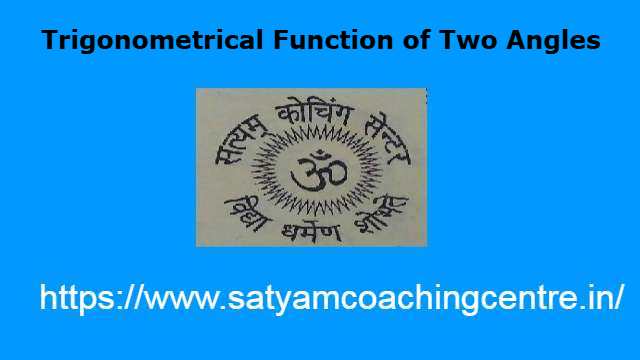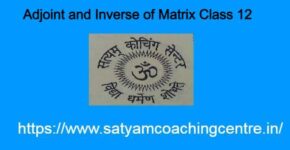Trigonometrical Function of Two Angles
1.दो कोणों के त्रिकोणमितीय फलन (Trigonometrical Function of Two Angles),सम्बद्ध कोणों के त्रिकोणमितीय अनुपात (Trigonometrical Ratio of Allied Angles):
दो कोणों के त्रिकोणमितीय फलन (Trigonometrical Function of Two Angles) के इस आर्टिकल में त्रिकोणमितीय कोणों के मान तथा सर्वसमिकाओं के आधार पर कुछ विशिष्ट सवालों को सिद्ध करेंगे।
आपको यह जानकारी रोचक व ज्ञानवर्धक लगे तो अपने मित्रों के साथ इस गणित के आर्टिकल को शेयर करें।यदि आप इस वेबसाइट पर पहली बार आए हैं तो वेबसाइट को फॉलो करें और ईमेल सब्सक्रिप्शन को भी फॉलो करें।जिससे नए आर्टिकल का नोटिफिकेशन आपको मिल सके।यदि आर्टिकल पसन्द आए तो अपने मित्रों के साथ शेयर और लाईक करें जिससे वे भी लाभ उठाए।आपकी कोई समस्या हो या कोई सुझाव देना चाहते हैं तो कमेंट करके बताएं।इस आर्टिकल को पूरा पढ़ें।
Also Read This Article:- Mathematical Reasoning in Class 11
2.दो कोणों के त्रिकोणमितीय फलन (Trigonometrical Function of Two Angles):
Illustration:1.निम्नलिखित के मान ज्ञात कीजिए:
Illustration:1(i). \sin 675^{\circ}
Solution: \sin 675^{\circ} \\ =\sin \left(2 \times 360^{\circ}-45^{\circ}\right) \\ =-\sin 45^{\circ} \\ \Rightarrow \sin 675^{\circ}=-\frac{1}{\sqrt{2}}
Illustration:1(ii). \sin 870^{\circ}
Solution: \sin 870^{\circ} \\ = \sin \left(2 \times 360^{\circ}+150^{\circ}\right) \\ =\sin 150^{\circ} \\ =\sin \left(188^{\circ}-30^{\circ}\right) \\ \Rightarrow \sin 870^{\circ}= \sin 30^{\circ} \\ =\frac{1}{2}
Illustration:1(iii). \cos \left(-420^{\circ}\right)
Solution: \cos \left(-420^{\circ}\right) \\ =\cos 420^{\circ} \quad \left[\cos (-\theta)=\cos \theta\right] \\ =\cos \left(360^{\circ}+60^{\circ}\right) \\ =\cos 60^{\circ} \quad\left[\cos \left(360^{\circ}+ \theta\right)=\cos \theta\right] \\ \Rightarrow \cos \left(-420^{\circ}\right)=\frac{1}{2}
Illustration:1(iv). \cos 675^{\circ}
Solution: \cos 675^{\circ} \\ =\cos \left(360^{\circ} \times 2+45^{\circ}\right) \\ =\cos 45^{\circ}\left[\cos \left(360^{\circ}+\theta\right)=\cos \theta\right] \\ \Rightarrow \cos 675^{\circ}=\frac{1}{\sqrt{2}}
Illustration:1(v). \tan 1650^{\circ}
Solution: \tan 1650^{\circ} \\ =\tan \left(4 \times 360^{\circ}+210^{\circ}\right) \\ =\tan 210^{\circ} \quad \left[\tan \left(360^{\circ}+\theta\right)=\tan \theta\right] \\ =\tan \left(180^{\circ}+ 30^{\circ} \right) \\ =\tan 30^{\circ} \quad\left[\tan \left(180^{\circ}+\theta\right)=\tan \theta\right] \\ \tan 1650^{\circ} =\frac{1}{\sqrt{3}}
Illustration:1(vi). \tan \left(-1770^{\circ}\right)
Solution: \tan \left(-1770^{\circ}\right) \\ =-\tan 1770^{\circ} \quad[\tan (-\theta)=-\tan \theta] \\ =-\tan \left[5 \times 360^{\circ}-30^{\circ}\right] \\ =\tan 30^{\circ} \quad\left[\tan \left(360^{\circ}-\theta\right)=-\tan \theta\right] \\ \Rightarrow \tan \left(-1770^{\circ}\right)=\frac{1}{\sqrt{3}}
Illustration:1(vii). \sec 1380^{\circ}
Solution: \sec 1380^{\circ} \\ =\sec \left(4 \times 360^{\circ}-60^{\circ}\right) \\ =\sec 60^{\circ} \quad\left[\because \sec \left(360^{\circ}-\theta\right)=\sec \theta\right] \\ \Rightarrow \sec 1380^{\circ}=2
Illustration:1(viii). \operatorname{cosec}\left(-1650^{\circ}\right)
Solution: \operatorname{cosec}\left(-1650^{\circ}\right) \\ =-\operatorname{cosec} \left(1650^{\circ} \right) \quad[\because \operatorname{cosec}(-\theta)=-\operatorname{cosec} \theta ] \\ =-\operatorname{cosec} \left[4 \times 360^{\circ}+210^{\circ}\right) \\ =-\operatorname{cosec} 210^{\circ} \quad \left[\because \operatorname{cosec} \left(360^{\circ}+\theta\right)=\operatorname{cosec} \theta\right] \\ =-\operatorname{cosec} \left(180^{\circ}+30^{\circ}\right) \\ =\operatorname{cosec} 30^{\circ}\left[\because \operatorname{cosec} \left(180^{\circ}+\theta\right)=-\operatorname{cosec} \theta\right] \\ \Rightarrow \operatorname{cosec} \left(-1650^{\circ}\right)=2
Illustration:2.निम्नलिखित कोणों को 45° या इससे कम धनात्मक कोण के अनुपात में ज्ञात कीजिएः
Illustration:2(i). \sin \left(-65^{\circ}\right)
Solution: \sin \left(-65^{\circ}\right) \\ =-\sin \left(65^{\circ}\right) \quad\left[ \because \sin (-\theta)=-\sin \theta\right] \\ =-\sin \left(90^{\circ}-25^{\circ}\right) \\ =-\cos 25^{\circ} \quad \left[\because \sin \left(90^{\circ}-\theta\right)=\cos \theta\right] \\ \Rightarrow \sin \left(-65^{\circ} \right)=-\cos 25^{\circ}
Illustration:2(ii). \tan 1145^{\circ}
Solution: \tan 1145^{\circ} \\=\tan \left(3 \times 360^{\circ}+65^{\circ}\right) \\ =\tan 65^{\circ} \quad\left[\because \tan \left(360^{\circ}+\theta\right)=\tan \theta\right] \\ =\tan \left(90^{\circ} -25^{\circ}\right) \\ =\cot 25^{\circ} \quad\left[\because \tan \left(90^{\circ}-\theta\right)=\cot \theta\right] \\ \Rightarrow \tan \left(1145^{\circ}\right)=\cot 25^{\circ}
Illustration:2(iii). \sec 2100^{\circ}
Solution: \sec 2100^{\circ} \\ =\sec \left(6 \times 360^{\circ}-60^{\circ}\right) \\ =\sec 60^{\circ} \quad \left[ \because \sec \left(360^{\circ}-\theta\right)=\sec \theta\right] \\ =\sec \left(90^{\circ} -30^{\circ}\right) \\ =\operatorname{cosec} 30^{\circ} \quad\left[ \because \sec \left(90^{\circ}-\theta\right)=\operatorname{cosec} \theta\right] \\ \Rightarrow \sec \left(2100^{\circ}\right) =\operatorname{cosec} 30^{\circ}
Illustration:2(iv). \cos \left(-1830^{\circ}\right)
Solution: \cos \left(-1830^{\circ}\right) \\ =\cos 1830^{\circ} \quad[\because \cos (-\theta)=\cos \theta] \\ =\cos \left(5 \times 360^{\circ}+30^{\circ}\right) \\ =\cos 30^{\circ} \quad\left[\because \cos \left(360^{\circ}+\theta\right)=\cos \theta\right] \\ \Rightarrow \cos \left(-1830^{\circ}\right)=\cos 30^{\circ}
Illustration:2(v). \sin 135^{\circ}
Solution: \sin 135^{\circ} \\ =\sin \left(90^{\circ}+45^{\circ}\right) \\ =\cos 45^{\circ} \quad\left[\because \sin \left(90^{\circ}+\theta\right)=\cos \theta\right] \\ \text { Alternate } \sin 135^{\circ}=\sin \left(180^{\circ}-45^{\circ}\right) \\ =\sin 45^{\circ}
अतः \sin \left(135^{\circ}\right)=\sin 45^{\circ} or \cos 45^{\circ}
Illustration:2(vi). \operatorname{cosec}\left(-225^{\circ}\right)
Solution: \operatorname{cosec}\left(-225^{\circ}\right) \\ =-\operatorname{cosec} \left(225^{\circ} \right)[\because \operatorname{cosec}(-\theta)=-\operatorname{cosec} \theta] \\ =-\operatorname{cosec} \left(180^{\circ}+45^{\circ}\right) \\ =\operatorname{cosec} 45^{\circ} \quad \left[\because \operatorname{cosec} \left(180^{\circ}+\theta\right)=-\operatorname{cosec} \theta\right] \\ \Rightarrow \operatorname{cosec}\left(-225^{\circ}\right)=\operatorname{cosec} 45^{\circ}
Illustration:3.सिद्ध कीजिए:
\sin 780^{\circ} \cdot \sin 120^{\circ}+\cos 240^{\circ} \cdot \sin 390^{\circ}=\frac{1}{2}
Solution: \sin 780^{\circ} \sin 120^{\circ}+\cos 240^{\circ} \sin 390^{\circ}=\frac{1}{2} \\ \text { L.H.S. } \sin 780^{\circ} \sin 120^{\circ}+\cos 240^{\circ} \sin 390^{\circ} \\ \sin \left(2 \times 360^{\circ}+ 60^{\circ}\right) \sin \left(180^{\circ}-60^{\circ}\right)+\cos \left(180^{\circ}+60^{\circ}\right) \sin \left(360^{\circ}+30^{\circ}\right) \\ =\sin 68^{\circ} \sin 60^{\circ}-\cos 60^{\circ} \sin 30^{\circ} \\ =\frac{\sqrt{3}}{2} \times \frac{\sqrt{3}}{2}-\frac{1}{2} \times \frac{1}{2} \\ =\frac{3}{4}-\frac{1}{4} \\ =\frac{3-1}{4}=\frac{1}{2}=\text { R.H.S }
Illustration:4. \theta के 0 व 2 \pi के मध्य सभी मान ज्ञात कीजिए जब:
Illustration:4(i). \sin \theta=\frac{1}{\sqrt{2}}
Solution: \sin \theta=\frac{1}{\sqrt{2}} \\ \Rightarrow \sin \theta=\sin 45^{\circ}, \sin \left( 180^{\circ} -45^{\circ}\right) \\ \Rightarrow \sin \theta=\sin 45^{\circ}, \sin 135^{\circ} \\ \Rightarrow \theta=45^{\circ}, 135^{\circ}
Illustration:4(ii). \sec \theta=-\frac{2}{\sqrt{3}}
Solution: \sec \theta=-\frac{2}{\sqrt{3}} \\ \Rightarrow \sec \theta=-\sec 30^{\circ},-\sec \left(360^{\circ}-30^{\circ}\right) \\ \Rightarrow \sec \theta=-\sec 30^{\circ},-\sec 330^{\circ} \\ \Rightarrow \sec \theta=\sec \left(180-30^{\circ}\right), \sec \left(180^{\circ}+30^{\circ}\right) \\ \Rightarrow \sec \theta=\sec 150^{\circ}, \sec 210^{\circ} \\ \Rightarrow \theta=150^{\circ}, 210^{\circ}
Illustration:4(iii). \tan \theta=-1
Solution: \tan \theta=-1 \\ \Rightarrow \tan \theta=\tan \left(180-45^{\circ}\right) , \tan \left(330^{\circ}-45^{\circ}\right) \\ \Rightarrow \theta=135^{\circ},315^{\circ}
Illustration:4(iv). \cos \theta=-\frac{\sqrt{3}}{2}
Solution: \cos \theta=-\frac{\sqrt{3}}{2} \\ \Rightarrow \cos \theta=\cos \left(180^{\circ}- 30^{\circ}\right), \cos \left(180^{\circ}+30^{\circ}\right) \\ \Rightarrow \cos \theta=\cos 150^{\circ}, \cos 210^{\circ} \\ \Rightarrow \theta=150^{\circ}, 210^{\circ}
Illustration:5.सिद्ध कीजिए
Illustration:5(i). \cos \theta+\sin \left(270^{\circ}+\theta\right)-\sin \left(270^{\circ}-\theta\right) +\cos \left(180^{\circ}-\theta\right)=0
Solution: \cos \theta+\sin \left(270^{\circ}+\theta\right)-\sin \left(270^{\circ}-\theta\right)+\cos \left(180^{\circ}-\theta\right)=0 \\ \text { L.H.S. } \cos \theta+\sin \left(270^{\circ}+\theta\right)-\sin \left(270^{\circ}-\theta\right)+\cos \left(180^{\circ}-\theta\right) \\ =\cos \theta+(-\cos \theta)-(-\cos \theta)-\cos \theta \\ =\cos \theta-\cos \theta+\cos \theta-\cos \theta \\ \Rightarrow 2 \cos \theta-2 \cos \theta \\ =0=\text { R.H.S. }
Illustration:5(ii). \sec \left(\frac{3 \pi}{2}-\theta\right) \sec \left(\theta-\frac{5 \pi}{2}\right)+\tan \left(\frac{5 \pi}{2}+\theta\right) \tan \left(\theta-\frac{3 \pi}{2}\right)=-1
Solution: \sec \left(\frac{3 \pi}{2}-\theta\right) \sec \left(\theta-\frac{5 \pi}{2}\right)+\tan \left(\frac{5 \pi}{2}+\theta\right) \tan \left(\theta-\frac{3 \pi}{2}\right)=-1 \\ \text { L.H.S. } \sec \left(\frac{3 \pi}{2}-\theta\right) \sec \left(\theta-\frac{5 \pi}{2}\right)+\tan \left(\frac{5 \pi}{2}+\theta\right)\tan \left(\theta-\frac{3 \pi}{2}\right) \\ =-\operatorname{cosec} \theta \sec \left(\frac{5 \pi}{2}-\theta\right)+\tan \left(360^{\circ}+90^{\circ}-\theta\right)\left[-\tan \left(\frac{3 \pi}{2}-\theta\right)\right] \\ = -\operatorname{cosec} \theta \sec \left(360^{\circ}+90^{\circ}-\theta\right)+\tan \left(90^{\circ}+ \theta\right) [-\cot \theta] \\ = -\operatorname{cosec} \theta \sec \left(90^{\circ}-\theta\right)+\cot \theta \cdot \cot \theta \\ = -\operatorname{cosec} \theta(\operatorname{cosec} \theta)+\cot ^2 \theta \\ = -\operatorname{cosec}^2 \theta +\cot ^2 \theta \\ = -\left(\operatorname{cosec}^2 \theta-\cot ^2 \theta\right) \\ =-1=\text { R.H.S }
Illustration:6.सिद्ध कीजिए
Illustration:6(i). \frac{\sin \left(180^{\circ}+\theta\right) \cos \left(90^{\circ}+\theta\right) \tan \left(270^{\circ}-\theta\right) \cot \left(360^{\circ} -\theta\right)}{\sin \left(360^{\circ}-\theta\right) \cdot \cos \left(360^{\circ}+\theta\right) \operatorname{cosec}(-\theta) \sin \left(270^{\circ}+ \theta\right)} =1
Solution: \frac{\sin \left(180^{\circ}+\theta\right) \cos \left(90^{\circ}+\theta\right) \tan \left(270^{\circ}-\theta\right) \cot \left(360^{\circ}-\theta\right)}{\sin \left(360^{\circ}-\theta\right) \cos \left(360^{\circ}+ \theta\right) \operatorname{cosec}(-\theta) \sin \left(270^{\circ}+\theta\right)}=1 \\ \text { L.H.S. } \frac{\sin \left(180^{\circ}+\theta\right) \cos \left(90^{\circ}+\theta\right) \tan \left(270^{\circ}-\theta\right) \cot \left(360^{\circ}-\theta\right)}{\sin \left(360^{\circ}-\theta\right) \cos \left(360^{\circ} +\theta\right) \operatorname{cosec}(-\theta) \sin \left(270^{\circ}+\theta\right)} \\ =\frac{(-\sin \theta)(-\sin \theta) \cot \theta(-\cot \theta)}{(-\sin \theta)(\cos \theta)(-\operatorname{cosec} \theta)(-\cos \theta)} \\ =\frac{\left(\sin ^2 \theta\right)(\cot \theta \cot \theta)}{(\sin \theta \operatorname{cosec} \theta) \cos ^2 \theta} \\ =\frac{\sin ^2 \theta \cot ^2 \theta}{\cos ^2 \theta} \quad[\because \sin \theta \operatorname{cosec} \theta=1] \\ =\frac{\sin ^2 \theta}{\cos ^2 \theta} \times \frac{\cos ^2 \theta}{\sin ^2 \theta}\left[\because \cot \theta=\frac{\cos \theta}{\sin \theta}\right] \\ =1=\text { R.H.S. }
Illustration:6(ii). \frac{\operatorname{cosec}\left(90^{\circ}+\theta\right)+\cot \left(450^{\circ}+\theta\right)}{\operatorname{cosec}\left(90^{\circ}-\theta\right)+\tan \left(180^{\circ}-\theta\right) }+\frac{\tan \left(180^{\circ}+\theta\right)+\sec \left(180^{\circ}-\theta\right)}{\tan \left(360^{\circ}+\theta\right)-\sec (-\theta)}=2
Solution: \frac{\operatorname{cosec}\left(90^{\circ}+\theta\right)+\cot \left(450^{\circ} +\theta\right)}{\operatorname{cosec}\left(90^{\circ}-\theta\right)+\tan \left(180^{\circ}-\theta\right) }+\frac{\tan \left(180^{\circ}+\theta\right)+\sec \left(180^{\circ}-\theta\right)}{\tan \left(360^{\circ}+ \theta\right)-\sec (-\theta)}=2 \\ \text{L.H.S.} \frac{\operatorname{cosec}\left(90^{\circ} +\theta\right)+ \cot \left(450^{\circ}+\theta\right)}{\operatorname{cosec}\left(90^{\circ}-\theta\right) +\tan \left(180^{\circ} -\theta\right)} +\frac{\tan \left(180^{\circ}+\theta\right)+\sec \left(180^{\circ}-\theta\right)}{\tan \left(360^{\circ}+\theta\right)-\sec (-\theta)} \\ =\frac{\sec \theta+\cot \left(90^{\circ} +\theta\right)}{\sec \theta-\tan \theta}+\frac{\tan \theta-\sec \theta}{\tan \theta-\sec \theta} \\ =\frac{\sec \theta-\tan \theta}{\sec \theta-\tan \theta}+1 \\ =1+1=2
Illustration:7.यदि A,B,C एवं D किसी चक्रीय चतुर्भुज के कोण हों,तो सिद्ध कीजिए:
Illustration:7(i). \cos A+\cos B+\cos C+\cos D=0
Solution: \cos A+\cos B+\cos C+\cos D=0 \\ \text { L.H.S. } \cos A+\cos B+\cos C+\cos D
A+C= \pi , B+D=\pi [चक्रीय चतुर्भुज के सम्मुख कोण सम्पूरक होते हैं]
\Rightarrow C=\pi-A, D=\pi-B \\ \cos A+\cos B+\cos (\pi-A)+\cos (\pi-B) \\ \Rightarrow \cos A+\cos B-\cos A-\cos B \\ =0=\text { R.H.S }
Illustration:7(ii). \sin A+\sin B-\sin C-\sin D=0
Solution: \sin A+\sin B-\sin C-\sin D=0 \\ \text { L.H.S. } \sin A+\sin B-\sin C-\sin D \\ A+C=\pi \Rightarrow C=\pi-A \\ B+D=\pi \Rightarrow D=\pi-B
[चक्रीय चतुर्भुज के सम्मुख कोण सम्पूरक होते हैं]
=\sin A+\sin B-\sin (\pi-A)-\sin (\pi-B) \\ =\sin A+\sin B-\sin A-\sin B \\ =0=\text { R.H.S }
Illustration:7(iii). \cos \left(180^{\circ}-A\right) +\cos \left(180^{\circ}-B\right)+\cos \left(180^{\circ}+C\right)-\sin \left(90^{\circ}+D\right)=0
Solution: \cos \left(180^{\circ}-A\right)+\cos \left(180^{\circ}-B\right)+\cos \left(180^{\circ} +C\right)-\sin \left(90^{\circ}+D\right)=0 \\ \text{L.H.S.} \cos \left(180^{\circ}-A\right)+\cos \left(180^{\circ}-B\right) +\cos \left(180^{\circ}+C\right)-\sin \left(90^{\circ}+D\right) \\ =-\cos A-\cos B-\cos C-\cos D \\ =-\cos A-\cos B-\cos (\pi-A)-\cos (\pi-B) \\ \quad[\because A+C=\pi, B+D=\pi) \\ =-\cos A-\cos B+\cos A+\cos B \\ =0=\text { R.H.S }
Illustration:8.यदि A,B एवं C किसी त्रिभुज के कोण हों,तो सिद्ध कीजिए:
Illustration:8(i). \sin (A+B)-\sin C=0
Solution:\sin (A+B)-\sin C=0 \\ \text{L.H.S.} \sin (A+B)-\sin C
A+B+C=180° [त्रिभुज के तीनों कोणों का योग]
\Rightarrow C=180^{\circ}-(A+B) \\ =\sin (A+B)-\sin \left[180^{\circ}-(A+B)\right] \\ \Rightarrow \sin (A+B)-\sin (A+B) \\ =0=\text{R.H.S.}
Illustration:8(ii). \sin \left(\frac{A+B}{2}\right)-\cos \frac{C}{2}=0
Solution: \sin \left(\frac{A+B}{2}\right)-\cos \frac{C}{2}=0 \\ \text{L.H.S. } \sin \left(\frac{A+B}{2}\right)-\cos \frac{C}{2}
A+B+C=180° [त्रिभुज के तीनों कोणों का योग]
\Rightarrow A+B=180^{\circ}-C \\ \Rightarrow \frac{A+B}{2}=90^{\circ}-\frac{C}{2} \\ =\sin \left(90^{\circ}-\frac{C}{2}\right)-\cos \frac{C}{2} \\ \Rightarrow \cos \frac{C}{2}-\cos \frac{C}{2} \\ =0=\text{R.H.S.}
Illustration:8(iii). \cos (A+B)+\cos C=0
Solution: \cos (A+B)+\cos C=0 \\ \text { L.H.S. } \cos (A+B)+\cos C \\ =\cos (180-C)+\cos C
A+B+C=180° [त्रिभुज के तीनों कोणों का योग]
=-\cos C+\cos C \\ =0=\text{R.H.S.}
Illustration:9.यदि A,B एवं C त्रिभुज के कोण हों,तो सिद्ध कीजिएः
Illustration:9(i). \tan \left(\frac{A+B-C}{2}\right)=\cot C
Solution: \tan \left(\frac{A+B-C}{2}\right)=\cot C
A+B+C=180° [त्रिभुज के तीनों कोणों का योग]
A+B=\pi-C
दोनों पक्षों में C घटाने परः
\Rightarrow A+B-C=\pi-2 C \\ \Rightarrow \frac{A+B-C}{2}=\frac{\pi-2 C}{2} \\ \Rightarrow \frac{A+B-C}{2}=90^{\circ}-C \\ \Rightarrow \tan \left(\frac{A+B-C}{2}\right)=\tan \left(90^{\circ}-C\right) \\ \Rightarrow \tan \left(\frac{A+B-C}{2}\right)=\cot C
Illustration:9(ii). \tan \left(\frac{A-B-C}{2}\right)=-\cot A
Solution: \tan \left(\frac{A-B-C}{2}\right)=-\cot A
A+B+C=180° [त्रिभुज के तीनों कोणों का योग]
\Rightarrow \quad B+C=\pi-A
दोनों पक्षों को A में से घटाने परः
A-(B+C)=A-(\pi-A) \\ \Rightarrow A-B-C=A-\pi+A \\ \Rightarrow A-B-C=-(\pi-2 A)
2 से भाग देने परः
\Rightarrow \frac{A-B-C}{2}=\frac{-(\pi-2 A)}{2} \\ \Rightarrow \tan \left(\frac{A-B-C}{2}\right)=\tan \left[-\left(\frac{\pi-2 A}{2}\right)\right. \\ \Rightarrow \tan \left(\frac{A-B-C}{2}\right)=-\tan \left(90^{\circ} -A\right) \\ \Rightarrow \tan \left(\frac{A-B-C}{2}\right)=-\cot A
Illustration:10.सिद्ध कीजिए:
\sec \left(270^{\circ}-\theta\right) \sec \left(90^{\circ}-\theta\right)-\tan \left(270^{\circ}-\theta\right) \tan \left(90^{\circ}+\theta\right)=-1
Solution: \sec \left(270^{\circ}-\theta\right) \sec \left(90^{\circ}-\theta\right)-\tan \left(270^{\circ}-\theta\right) \tan \left(90^{\circ}+\theta\right)=-1 \\ \text{L.H.S. } \sec \left(270^{\circ}-\theta\right) \sec \left(90^{\circ}-\theta\right)-\tan \left(270^{\circ}-\theta\right) \tan (90^{\circ}+\theta) \\ =-\operatorname{cosec} \theta \operatorname{cosec} \theta-\cot \theta(-\cot \theta) \\ =-\operatorname{cosec}^2 \theta+\cot ^2 \theta \\ =-\left(\operatorname{cosec}^2 \theta-\cot ^2 \theta\right) \\ =-1=\text { R.H.S. }
Illustration:11.निम्नलिखित समीकरण से x का मान ज्ञात कीजिए:
x \cot \left(90^{\circ}+\theta\right)+\tan \left(90^{\circ}+\theta\right) \sin \theta+ \operatorname{cosec} \left(90^{\circ}+\theta\right)=0
Solution: x \cot \left(90^{\circ}+\theta\right)+\tan \left(90^{\circ}+\theta\right) \sin \theta+ \operatorname{cosec}\left(90^{\circ}+\theta\right)=0 \\ \Rightarrow x(-\tan \theta)-\cot \theta \sin \theta+\sec \theta=0 \\ \Rightarrow-x \tan \theta=\cot \theta \sin \theta-\sec \theta \\ \Rightarrow-x \tan \theta=\cos \theta-\frac{1}{\cos \theta} \\ \Rightarrow-x \tan \theta=\frac{1-\cos ^2 \theta}{\cos \theta} \\ \Rightarrow-x=-\left(\frac{1-\cos ^2 \theta}{\cos ^2 \theta}\right) \frac{1}{\tan \theta} \\ \Rightarrow-x=-\left(\frac{1-\cos ^2 \theta}{\cos \theta}\right) \times \frac{\cos \theta}{\sin \theta}=\frac{-\sin ^2 \theta}{\sin \theta} \\ \Rightarrow x=\sin \theta
उपर्युक्त उदाहरणों के द्वारा दो कोणों के त्रिकोणमितीय फलन (Trigonometrical Function of Two Angles),सम्बद्ध कोणों के त्रिकोणमितीय अनुपात (Trigonometrical Ratio of Allied Angles) को समझ सकते हैं।
3.दो कोणों के त्रिकोणमितीय फलन पर आधारित सवाल (Questions Based on Trigonometrical Function of Two Angles):
(1.)निम्न समीकरण में x का मान ज्ञात कीजिए:
\operatorname{cosec}\left(90^{\circ}+\theta\right)+x \cos \theta \cot \left(90^{\circ}+\theta\right)=\sin \left(90^{\circ}+\theta\right)
(2.)सिद्ध कीजिए कि
\cos \left(\frac{10 \pi}{13}\right) + \cos \left(\frac{8 \pi}{13}\right)+\cos \left(\frac{3 \pi}{13} \right)+\cos \left(\frac{5 \pi}{13}\right)=0
उत्तर (Answer): (1.) x=\tan \theta
उपर्युक्त सवालों को हल करने पर दो कोणों के त्रिकोणमितीय फलन (Trigonometrical Function of Two Angles),सम्बद्ध कोणों के त्रिकोणमितीय अनुपात (Trigonometrical Ratio of Allied Angles) को ठीक से समझ सकते हैं।
Also Read This Article:- Validating Statements Class 11
4.दो कोणों के त्रिकोणमितीय फलन (Trigonometrical Function of Two Angles),सम्बद्ध कोणों के त्रिकोणमितीय अनुपात (Trigonometrical Ratio of Allied Angles) से सम्बन्धित अक्सर पूछे जाने वाले प्रश्न:
प्रश्न:1.सम्बद्ध कोण की परिभाषा दीजिए। (Define the Allied Angles):
उत्तर:यदि दो कोणों का योग अथवा अन्तर शून्य या 90^{\circ}\left(\frac{\pi}{2}\right) का गुणज हो,तो ऐसे कोण सम्बद्ध कोण कहलाते हैं।
प्रश्न:2.त्रिकोणमिति में आवर्ती फलन को स्पष्ट करो। (Explain the Periodic Function):
उत्तर:एक फलन f(x) आवर्ती फलन है यदि x के सभी मानों के लिए एक धनात्मक वास्तविक संख्या T इस प्रकार विद्यमान हो कि
f(x+T)=f(x)
यदि T एक न्यूनतम धनात्मक संख्या हो जिसके लिए f(x+T)=f(x) हो,तो T फलन f(x) का आवर्तकाल (periodic time) कहलाता है।
हम जानते हैं कि \sin (2 \pi+\theta)=\sin \theta \\ \cos (2 \pi+\theta)=\cos \theta \\ \tan (\pi+\theta)=\tan \theta \\ \cot (\pi+\theta)=\cot \theta \\ \sec (2 \pi+\theta) =\sec \theta \\ \operatorname{cosec}(2 \pi+\theta)=\operatorname{cosec} \theta अर्थात् \sin \theta, \cos \theta , \sec \theta एवं \operatorname{cosec} \theta आवर्ती फलन हैं जिनका आवर्तकाल 2 \pi एवं \tan \theta और \cot \theta भी आवर्ती फलन हैं परन्तु इनका आवर्तकाल \pi है।
प्रश्न:3.त्रिकोणमिति में सम व विषम फलन का पता कैसे लगाते हैं? (How to Find Even and Odd Functions in Trigonometry?):
उत्तर:फलन f(\theta) सम फलन कहलाता है यदि \theta के सभी मानों के लिए f(-\theta)=f(\theta) हो
तथा विषम फलन कहलाता है यदि f(-\theta)=-f(\theta) हो।
हम जानते हैं कि
\sin (-\theta)=-\sin \theta ; \tan (-\theta)=-\tan \theta ; \cot (-\theta)=-\cot \theta एवं \cos (-\theta)=\cos \theta ; \sec (-\theta)=\sec \theta ; \operatorname{cosec}(-\theta)=-\operatorname{cosec} \theta
अर्थात् \sin \theta, \tan \theta, \cot \theta, \operatorname{cosec} \theta विषम फलन एवं \cos \theta, \sec \theta सम फलन हैं।
उपर्युक्त प्रश्नों के उत्तर द्वारा दो कोणों के त्रिकोणमितीय फलन (Trigonometrical Function of Two Angles),सम्बद्ध कोणों के त्रिकोणमितीय अनुपात (Trigonometrical Ratio of Allied Angles) के बारे में और अधिक जानकारी प्राप्त कर सकते हैं।
| No. | Social Media | Url |
|---|---|---|
| 1. | click here | |
| 2. | you tube | click here |
| 3. | click here | |
| 4. | click here | |
| 5. | Facebook Page | click here |
| 6. | click here | |
| 7. | click here |
Trigonometrical Function of Two Angles
दो कोणों के त्रिकोणमितीय फलन
(Trigonometrical Function of Two Angles)
Trigonometrical Function of Two Angles
दो कोणों के त्रिकोणमितीय फलन (Trigonometrical Function of Two Angles) के इस आर्टिकल
में त्रिकोणमितीय कोणों के मान तथा सर्वसमिकाओं के आधार पर कुछ विशिष्ट सवालों को सिद्ध करेंगे।








